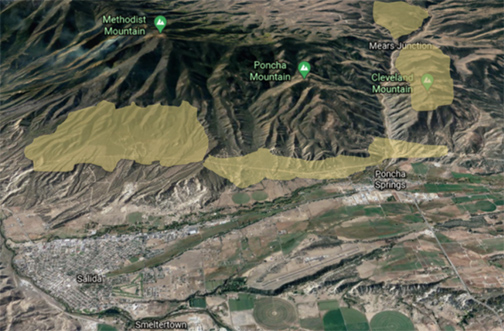Envision Forest Health Council partners will host a community information session to share details and answer questions about a wildfire mitigation and forest health enhancement project within the foothills of Methodist Mountain extending to Poncha Pass, an area threatened by the 2019 Decker Fire.
The meeting to be streamed live on Facebook is set for Wednesday, Dec. 16 from 5″00 to6:15 p.m. Click here to join the Zoom meeting with passcode 528952 or find Envision on Facebook.
The Methodist Front project protects the southern flank of the Salida and Poncha Springs communities of 7,000 people by creating a 10-mile area of fuel breaks on public and private lands. Tree thinning also enhances wildlife habitat within the 8,000-acre project area.
The Methodist Front project was originally announced this summer and has since expanded in size and received $2.3 million in funding, including a $366,310 grant award from the RESTORE Colorado Program. Funding also comes from the U.S. Forest Service, the municipalities of Salida and Poncha Springs, and the Chaffee Common Ground Fund.
Private property work on nearly 500 acres is managed by the Salida Field Office of the Colorado State Forest Service to connect $1.1 million in treatments on city, state and privately owned lands to create the fuel breaks. Planned treatments to begin in early 2021 include the Hutchinson Ranch and additional properties that are important water source locations.
The Forest Service will focus on 2,700 acres on Cleveland Mountain and 2,200 acres on Poncha Pass, where treatments include the Poncha Loop network of roads, O’Haver Lake, Silver and Poncha creeks, the Shirley Recreation Site and power lines that transfer electricity in and out of the San Luis Valley and Poncha area. The Bureau of Land Management has already completed treatment in the Cherokee Heights area and plans to continue work near Poncha Pass.
The large project combining federal and state agencies, county and city governments, private landowners and local fire departments came together quickly on the heels of the new Chaffee County Community Wildfire Protection Plan (CWPP) approval in February.
Planned forest restoration work involves hand-cutting and mastication, a process that shreds or chops smaller trees and shrubs into pieces to encourage grasses to thrive. Prescribed burning will occur on public lands, depending on weather and other conditions.
Methodist Front improves wildlife habitat by enhancing grass cover and forage for a variety of species such as elk, deer, turkey and many others. It also protects:
- The Gold Medal trout waters of the Arkansas River, by reducing the likely intensity of a wildfire in the forests above the South Arkansas River
- The Harrington and Del Monte ditches
- Municipal drinking water supplies, agricultural lands and wetlands
- Major power transmission lines and a critical communications site to the south of Highway 50
Methodist Front is a top treatment priority area identified in the CWPP, which uses computer modeling to map wildfire risk and identify the right areas to treat for the highest cost efficiency and community benefit. The Forest Health Council was formed to implement the CWPP, to increase the past rate of forest treatments and reduce overall risk of the effects of a wildfire.
Methodist Front significantly addresses the Forest Health Council’s goal to treat 30,000 acres by 2030,said U.S. Forest Service Salida District Ranger Jim Pitts. He is among more than 30 members of the Council.
“The Decker Fire burned the eastern side of Methodist Mountain but there are still heavy fuel loads in the forest,” Pitts said. “The Methodist Front project proactively addresses consequences as seen in recent Decker and Hayden Pass fires.”








Recent Comments